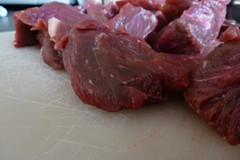
![]() Germs are everywhere in the environment inside and outside the house and on our bodies. In most cases they are harmless and they often help in the proper functioning of our body. For example, stomach bacteria help with good digestion and skin bacteria protect us from infection. However, there are some microbes that are dangerous to our health, especially when they enter our body through food.
Germs are everywhere in the environment inside and outside the house and on our bodies. In most cases they are harmless and they often help in the proper functioning of our body. For example, stomach bacteria help with good digestion and skin bacteria protect us from infection. However, there are some microbes that are dangerous to our health, especially when they enter our body through food.
Today I am starting with some basic food safety rules. They are more or less our mom’s rules – the ones we all tend to forget as university students, since we lived on take aways at that glorious time. The idea is to explore the 4 “magic” Cs. What does this mean? You’ll know pretty soon.
So, let’s start with the first C for cross contamination.
C: Cross Contamination
As mentioned above, germs are everywhere. They can invade our food from sources such as hands, towels, sponges and cloths we use in the kitchen, from insects and bugs sitting on our food (especially now in the summer), from damaged or dirty utensils and surfaces in the kitchen, and they can even spread from one food to another.
So to avoid contamination we should:
- Wash our hands thoroughly before we start cooking, and between handling different foods e.g. after having cut the meat and before we cut the vegetables. Also if we touch our faces, and after going to the loo.
- We gather our hair or pin it back to prevent hair from falling into food or onto the surfaces of the kitchen
- We avoid touching our face (nose, eyes, etc.) as it is easy to transfer germs from your face to the food and vice versa
- We use clean towels, sponges, etc to clean the surfaces of the kitchen especially if we make raw food eg salads
- Avoid leaving food uncovered on kitchen counters (unless it is hot) to avoid contact with insects, etc.
- Raw meat, fish and vegetables should not come into contact with each other nor come into contact with cooked foods (high temperature kills bacteria but the cooked food is already cooked!)
- Be careful that raw meat juices do not come in contact with other foods in the refrigerator. So always store the meat in a sealed container in the bottom of the refrigerator.
- We never use the same cutting board (if not cleaned thoroughly), or knife for raw meat, chicken, fish and vegetables.
- Avoid washing meat before cooking. If you do you may spread germs onto all surrounding surfaces. If you need to wash the meat (e.g, where you need to take the entrails of a chicken out) do it very carefully – the water flow pressure should not be too high and always keep the meat low into the sink.
Also for perfectionists:
- Wear an apron which you can easily wash
- Also, it’s generally a good idea to keep your rubbish bin closed as it may attract various living organisms (some small and some big e.g. grey with whiskers) and they will make the jump to your food.
Further reading material:
——————-
Photograph: Plain blue and pink polyurethane kitchen sponges by Horia Varlan

